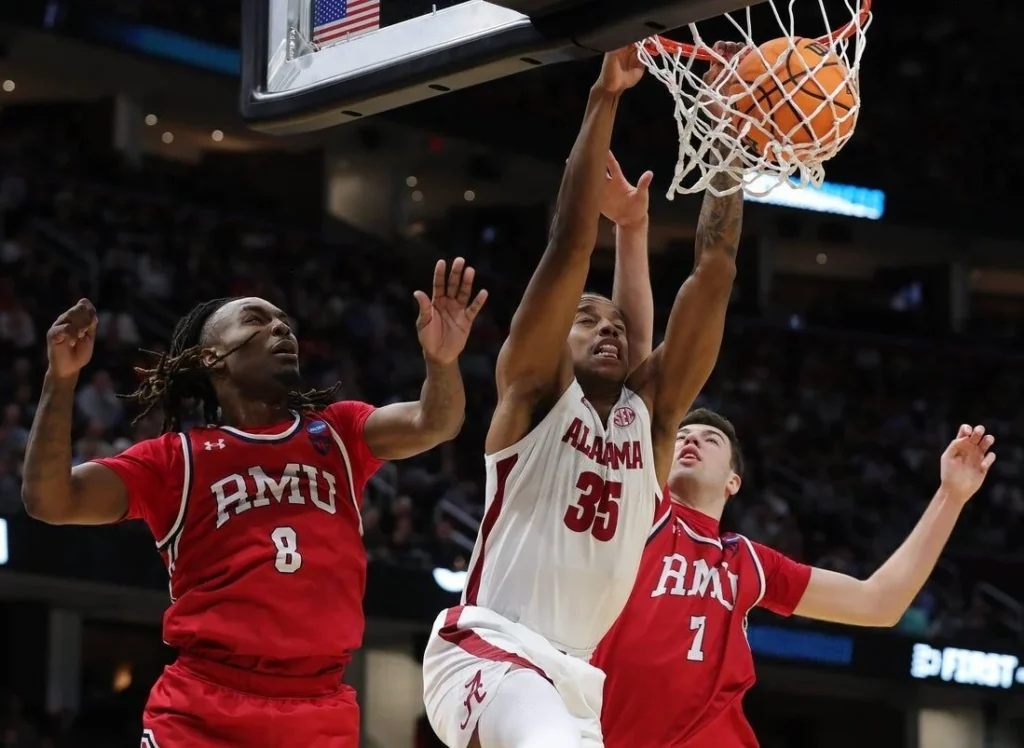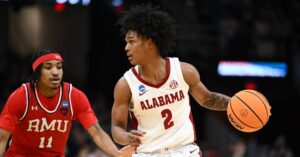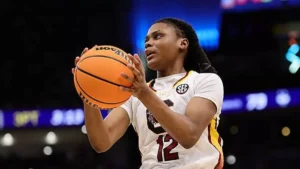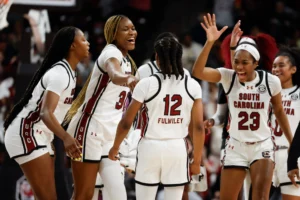
Breaking: Derrion Reid, a transfer forward from Alabama and a former 5-Star prospect, has committed to Oklahoma basketball.
In a pivotal addition that could reshape the trajectory of Oklahoma basketball under head coach Porter Moser, former Alabama forward and five-star prospect Derrion Reid has officially committed to the Sooners. The commitment, which comes amid a wave of high-profile movement in the transfer portal, signals both a coup for the Oklahoma program and a fresh opportunity for Reid to recapture the promise that made him one of the most sought-after recruits in the nation just a year ago.
Reid, who entered the portal after a limited freshman campaign with the Crimson Tide, is expected to immediately bolster Oklahoma’s frontcourt and inject star potential into a program looking to gain footing in a competitive Big 12 landscape. His commitment marks one of the biggest portal wins for the Sooners since the NCAA implemented one-time transfer eligibility.
Hailing from Grovetown, Georgia, Derrion Reid was a consensus five-star prospect in the class of 2024. Ranked as high as No. 15 nationally by Rivals and firmly within the top 30 on every major recruiting board, Reid drew scholarship offers from Kansas, Georgia, Texas, and Auburn, among others, before ultimately signing with Alabama.
A versatile 6-foot-7 forward with a 7-foot wingspan, Reid brought a unique blend of size, athleticism, and court vision to the high school level. His ability to defend multiple positions, handle the ball in transition, and stretch the floor offensively made him a prized gem for Alabama’s 2024 recruiting class.
However, Reid’s freshman year in Tuscaloosa never fully materialized into the breakout many projected. Despite a strong showing in summer workouts, Reid found himself buried in a crowded Alabama rotation that included NBA-caliber wings and veteran frontcourt players. He averaged just 6.8 minutes per game in 17 appearances, posting modest numbers of 2.1 points and 1.5 rebounds per contest.
Still, flashes of his upside were evident. In Alabama’s midseason non-conference win over Liberty, Reid posted 11 points and five rebounds in just 12 minutes, showcasing the athletic tools and instincts that once made him a McDonald’s All-American nominee. But as Alabama pursued an SEC title and made another deep NCAA Tournament run, playing time was hard to come by for underclassmen, prompting Reid to explore his options through the transfer portal.
Reid’s decision to commit to Oklahoma surprised some in recruiting circles, as traditional powerhouses like Kentucky and Arkansas were also believed to be in pursuit. But sources close to the recruitment indicate that Oklahoma’s pitch was personalized, clear, and convincing: Come to Norman, and be the face of a new era.
Porter Moser, now entering a pivotal fifth year as head coach of the Sooners, has made it a mission to retool his roster with high-upside transfers and dynamic athletes who can compete in the ever-intensifying Big 12 arms race. Oklahoma’s 2024-25 team will look markedly different than last season’s group that narrowly missed out on an NCAA Tournament berth. The Sooners finished 20-12 overall but struggled late in conference play, prompting Moser to explore high-impact additions through the portal.
Reid, with three years of eligibility remaining, fits that mold perfectly.
“I wanted to go somewhere I could grow, be coached hard, and have a chance to lead,” Reid told ESPN shortly after announcing his decision. “Coach Moser made it clear that I wouldn’t just be another piece. I’d be someone they build around.”
That kind of opportunity wasn’t necessarily available at Alabama, where talent depth has become a luxury and rotations often favor experienced players in the heat of SEC contention. In contrast, Oklahoma can offer Reid both playing time and a system more suited to his perimeter-oriented game.
Reid brings a modern skill set to Oklahoma’s forward position. Defensively, his lateral quickness and wingspan allow him to switch onto guards and contest shots on the perimeter. Offensively, he can attack off the dribble, score in transition, and knock down mid-range jumpers with consistency. Though still developing his three-point shot, Reid’s form is sound and his confidence growing.
More importantly, Reid gives the Sooners a dynamic, two-way player who can create mismatches across the board. He is expected to slot in as a hybrid forward, likely starting at the “3” or “4” depending on lineup configurations. His presence will also help open up space for returning guard Javian McCollum and wing Otega Oweh, assuming both return for another season.
“He has the kind of ceiling you build a program around,” one Big 12 assistant coach told On3 Sports. “If Oklahoma gives him the keys, and lets him play through some mistakes, he could be a top-three scorer in the league by January.”
Given Oklahoma’s recent history of player development—turning underrated prospects like Buddy Hield and Austin Reaves into NBA talents—there’s reason to believe Reid could thrive in Norman.
Reid’s commitment also illustrates a larger shift in how elite talent navigates early struggles in college basketball. Just a few years ago, a freshman season like Reid’s at Alabama might have led to multiple years riding the bench before an eventual breakout. Now, with the advent of the transfer portal and immediate eligibility rules, high-profile players can seek fresh starts without penalty.
For Oklahoma, the portal has been both a necessity and a weapon. Since Moser’s arrival, the Sooners have cycled through more than a dozen transfers, using the portal to plug holes and replenish their roster. Reid represents a different kind of transfer: one with untapped upside and long-term development potential.
“Reid is a foundational piece,” said 247Sports analyst Eric Bossi. “He’s not a stopgap. He’s someone who could be there for two or three years and evolve into a legitimate All-Big 12 candidate.”
To maximize Reid’s value, Oklahoma will need to structure its offense around his strengths—giving him freedom to create, but also surrounding him with shooters and ball-handlers who can space the floor. It’s a gamble, to be sure. But for a program still seeking its post-Trae Young identity, it may be exactly the kind of bold swing that leads to tournament success.
Though Alabama fans are disappointed to lose a prospect of Reid’s caliber, the move is not wholly unexpected. With Nate Oats adding more star power in the 2025 recruiting class and returning key contributors, Reid faced an uphill battle for meaningful minutes in Tuscaloosa. His departure also frees up a scholarship for Alabama to potentially add a veteran wing or shooting specialist through the portal.
“Reid is a great kid and has all the tools to be a star,” Oats said in a statement. “We wish him nothing but success at Oklahoma. He’s going to do big things.”
SEC insiders note that Reid’s departure reflects a reality for elite programs: not every top-30 recruit will get minutes immediately, and the portal now provides an easy escape route. Alabama has handled it as well as any program, regularly recruiting over losses and maintaining top-tier talent depth.
With Reid now officially in the fold, Oklahoma’s attention turns to rounding out its roster with complementary pieces. The Sooners are reportedly targeting a stretch-five to pair with Reid in the frontcourt, as well as a veteran wing to help stabilize the rotation. If those additions materialize, Oklahoma could enter next season with its most talented lineup since the Buddy Hield era.
More importantly, Reid’s presence offers hope for the future—not just in terms of wins, but in branding. Landing a former five-star with name recognition sends a message to future recruits: Oklahoma is a viable destination for elite talent seeking impact roles and long-term development.
And in today’s college basketball climate, where perception often influences recruiting momentum, that kind of signal is invaluable.
Derrion Reid’s transfer to Oklahoma is more than just a roster move. It’s a statement. It’s a second chance for a former elite recruit, a strategic win for a program seeking an identity, and a signal that the Sooners are ready to compete with the Big 12’s elite.
For Reid, it’s a reset button. For Oklahoma, it’s a blueprint.
If the union pays off, both player and program may look back at this commitment as the turning point that launched something special.





